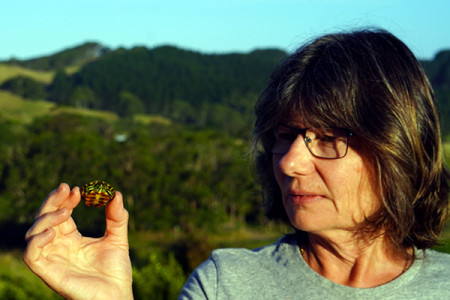
Jayne, with help from the community, has removed 76 turtles from the ponds and surrounding areas.
Jayne Nightingale stuck her neck out for Waikato Regional Council when she first started catching and removing red-eared slider turtles from the Cooks Beach ponds about four years ago.
“I was met with lots of negativity as there were locals who liked to see the turtles in what they saw as their natural habitat,” says Jayne, who’s passionate about getting on top of red-eared sliders in our environment before they become a real ecological pest.
“I even found on the local Facebook page someone saying how they had released a breeding pair back in 2013! It’s my assumption that from those first two released, others have thought it was a good place to dump their pets as well, because they are cute when small but soon outgrow the aquarium.
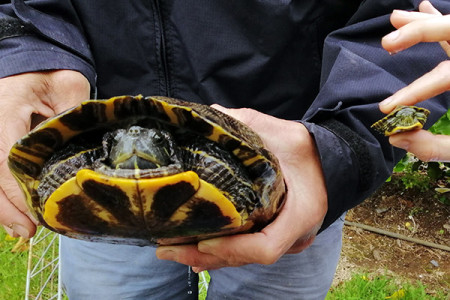
Turtles grow quickly to up to the size of a dinner plate.
“So, I got out into the community and shared information how they are not native and how harmful they are to our already fragile freshwater ecosystems and since then I have had people helping to catch them, and people contacting me when they found them on their property.”
So far, Jayne – with help from the community – has removed 76 turtles from the ponds and surrounding areas.
The caught turtles get handed over to a University of Waikato professor who is studying the impacts of red-eared slider turtles in the wild in New Zealand.
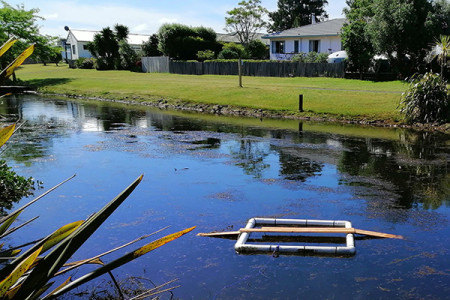
The basking platform is built over a basket and catching a turtle depends on which way it slides back into the water.
Red-eared sliders, which can live up to 50 years, are among the top 100 worst invasive species in the world.
Like many pest species, they are highly adaptable and can tolerate a wide variety of aquatic environments. As omnivores they can impact a wide variety of aquatic plants, insects, eels and small fish species. They can take over nests of water birds to use as basking sites, and they are known to eat eggs and young birds.
Jayne says she was walking with a friend around the storm ponds back in 2020 and was surprised to see several turtles basking in the sun.
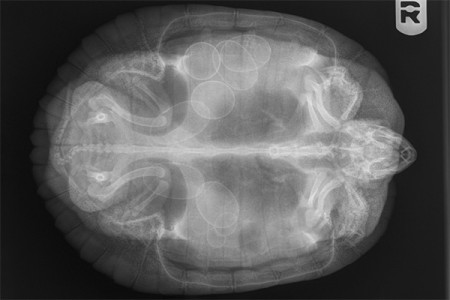
An X-ray of one of female turtles caught shows she is carrying eggs.
“I contacted Waikato Regional Council, and they were aware of the turtles but had no one on the ground to set up a trap and check it regularly.
“I volunteered because as a former biosecurity officer I was very concerned knowing they would be breeding and that they could move from the ponds and into our natural waterways.
“There has been sightings close by of a rare white banded rail, fernbirds, Australasian bittern and dabchicks, and we cannot risk these rare native birds.”
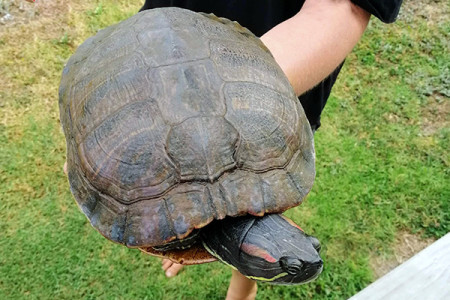
Eleven large female turtles have been removed from the ponds.
The council gave Jayne a trap in the form of basking platform, made from downpipes around a basket.
The floating platform has ramps so turtles can get up on it, and catching a turtle depends on which way it slides back into the water.
“I have been contacted by council biosecurity officers around New Zealand asking how we’re doing it as they have not been able to control the spread in their areas,” says Jayne.
She says 11 of the turtles caught have been large breeding females that were found digging nests in residents’ gardens.
“These 11 females would all have been illegally released pets because there are no known cases of female turtles having hatched in the wild in New Zealand.”
Pet turtles are allowed for sale in New Zealand because it was thought the climate was too cold for their eggs to successfully incubate and hatch.
A female turtle can walk several kilometres looking for a nesting spot and can remain fertilised for up to five years. She can lay two to three clutches of about 11 eggs per clutch every year.
“It is the ground temperature that determines the sex of the offspring. Lower temperatures produce males, and our temperatures generally aren’t high enough to produce females unless they’re breeding in geothermal areas.
“But with rising temperatures with climate change, there will be a more sustainable breeding environment across New Zealand.”
Jayne, who was also scooping up baby turtles with a net from the ponds, says she’s hopeful she’s down to catching just a remaining few at Cooks Beach now.
“In January I collected a large female that was found digging a nest, so I am hoping this is the last female, and it’s just males left.
“At the end of summer, I only saw four medium sized ones, and a couple of people that live by the ponds say they are only seeing this small number as well.”
To knowingly release red-eared sliders into a wetland in the Waikato region is an offence under the Biosecurity Act.

